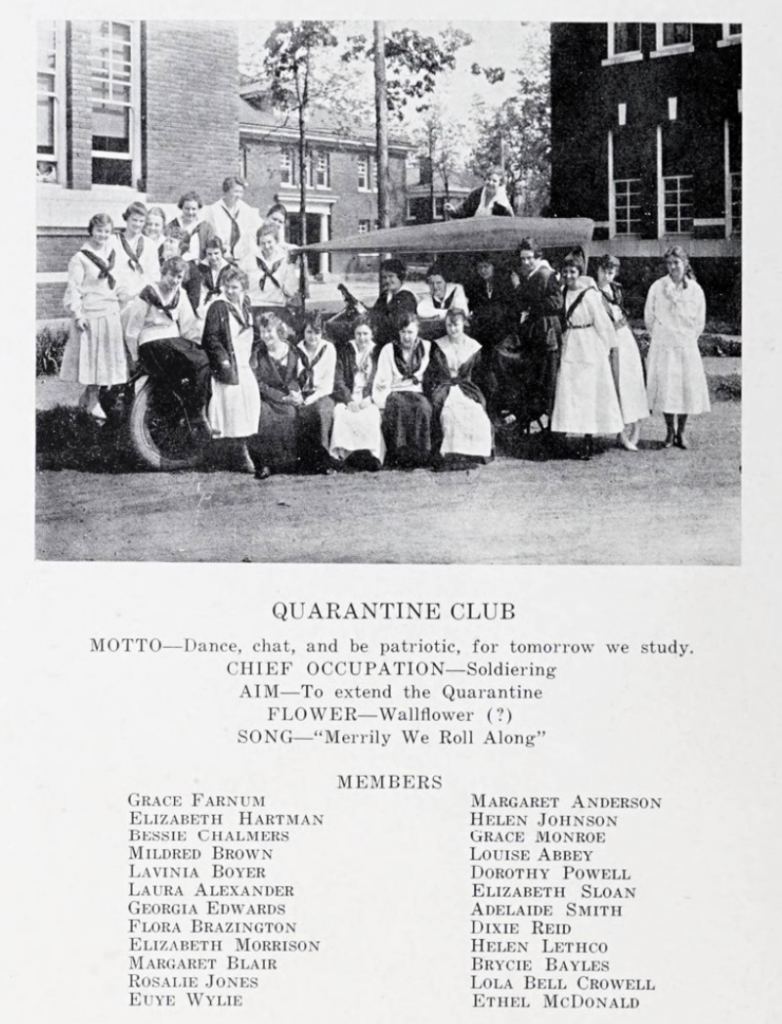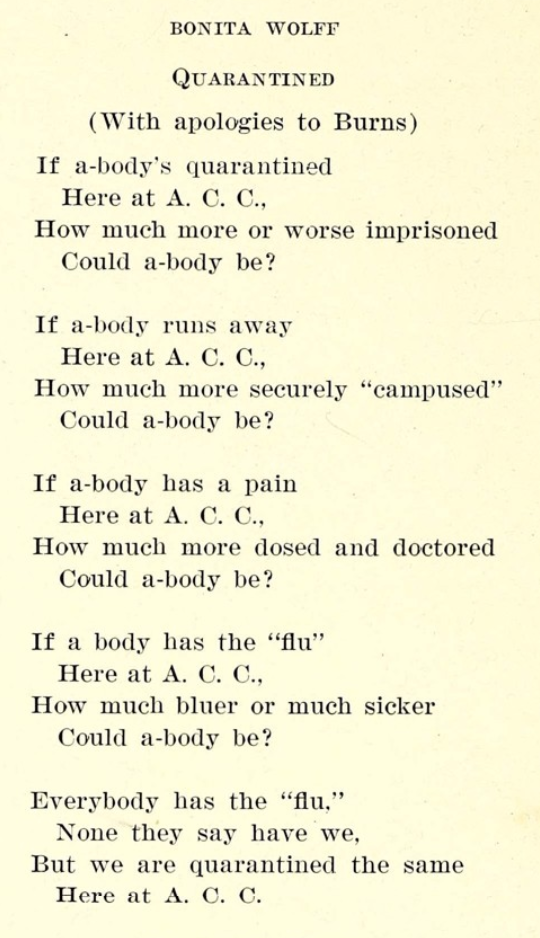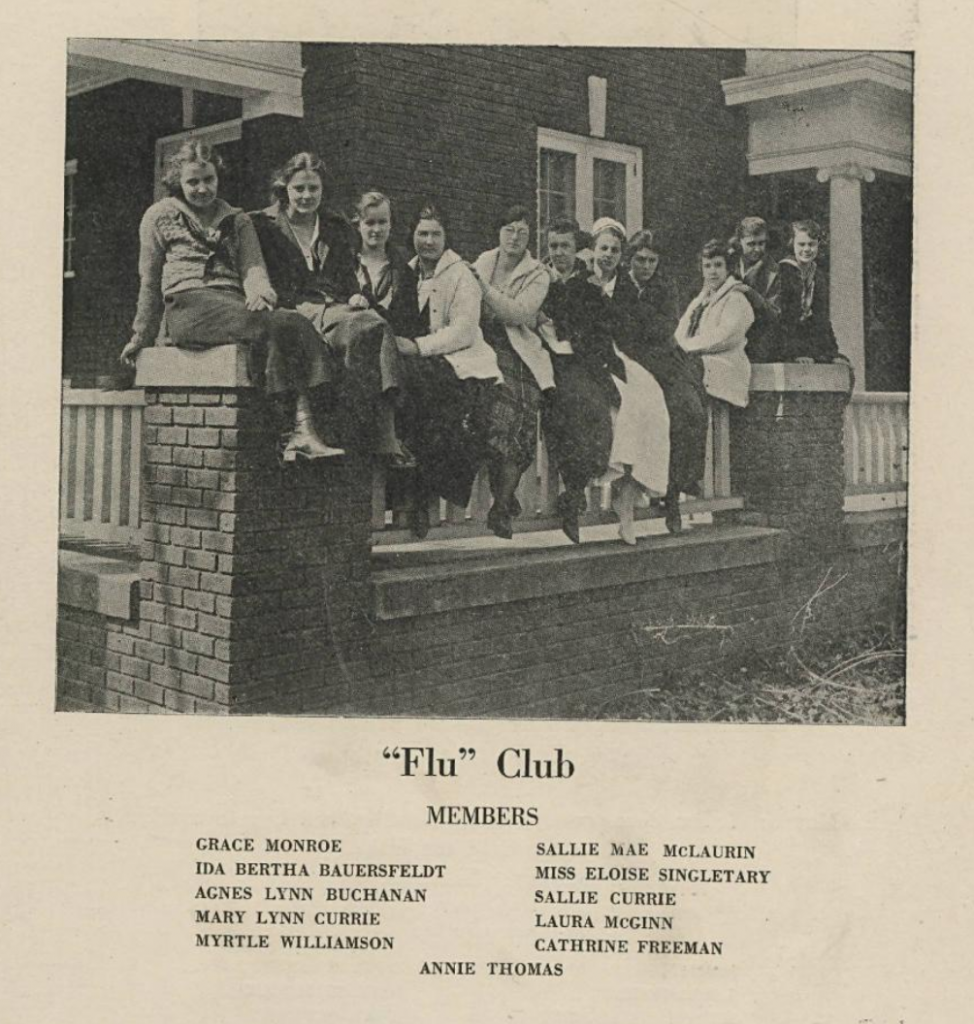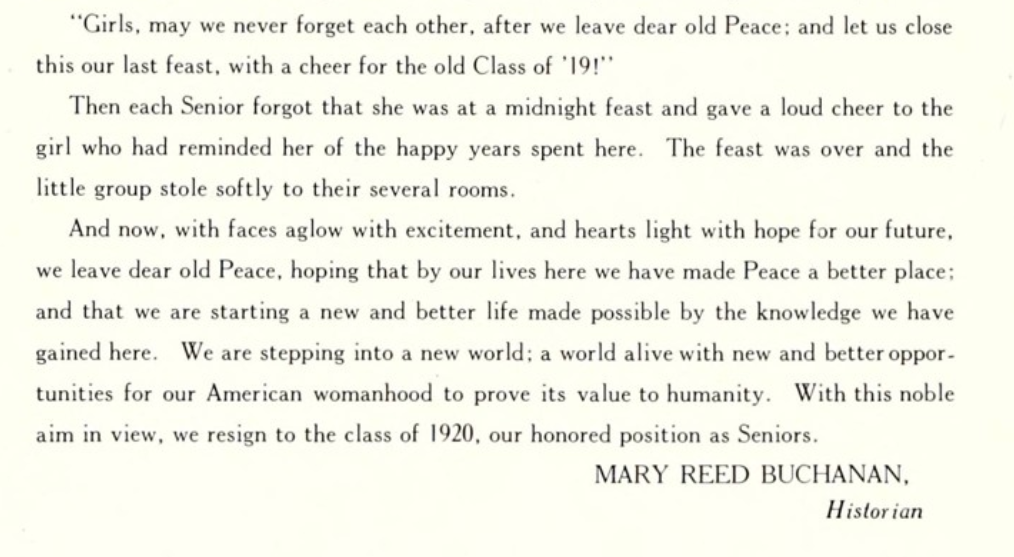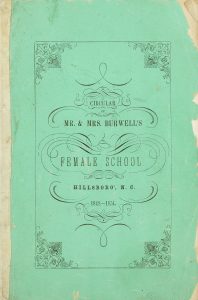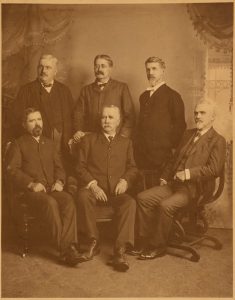Viewing search results for "Queens University of Charlotte"
View All Posts
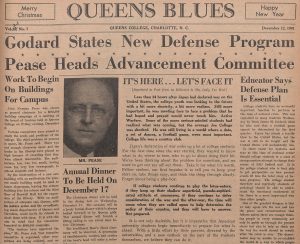
Front page of Queens Blues, 12/12/1941 – Queens students grapple with war
A new batch of newspapers from Queens University of Charlotte is now online. The batch covers a 20 year span (1931-1951) of Queens Blues, the student newspaper for Charlotte’s Queens College. An all female liberal arts institution, Queens College began admitting male students after the Second World War and later became Queens University of Charlotte. The issues provide interesting insights into the world of young, educated women during a crucial period in American history – The Great Depression and World War II. The contents largely concern themselves with goings-on at the school itself, but touch upon wider events as well. The front page shown above, for example, illustrates how college students reacted to the Japanese attack on Pearl Harbor and America’s entry into World War II.
The newly digitized materials are an addition to the considerable amount of Queens University materials already online at DigitalNC. Visit their DigitalNC partner page here or head to the QUC Library website for more information.
The Charlotte Mecklenburg Library sent us quite a few yearbooks from the early 20th century. The majority come from Presbyterian College for Women (later Queens College and Queens University), Elizabeth College, and Mecklenburg Female College. These yearbooks highlight the friendships built among the young women, as well as their concerns and interests.
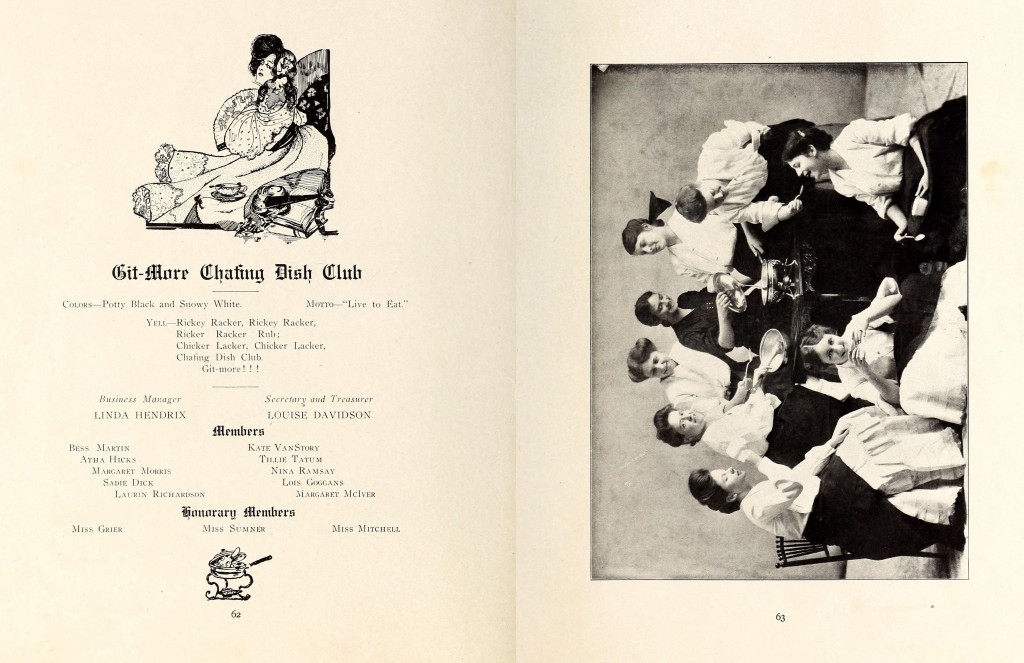
Git-More Chafing Dish Club, Presbyterian College for Women, 1905.
These 21 yearbooks, dating from 1904-1934, come to us from Queens University of Charlotte and its several precursor schools. According to NCpedia, the women’s school in Charlotte was founded in 1857 and known in sequence as: Charlotte Female Institute, Seminary for Girls, Presbyterian College for Women, and Queens College. It merged with the South Carolina school Chicora College in 1930 and was known as Queens-Chicora College for almost a decade. The school began accepting both genders in 1946, and in 2002 became Queens University of Charlotte.
The yearbooks are full of personality, with delightful drawings and quirky clubs. Some favorites: Git-More Chafing Dish Club, Gitchimanito Club (i.e. “get ye a man or two”), The Suffragettes, Old Maids’ Club, Babes in the Wood, Tom Thumb Crowd (for students who measured five feet or less), the Red-Headed Stepchildren, and Witches’ Club. Many volumes also include delightful drawings.
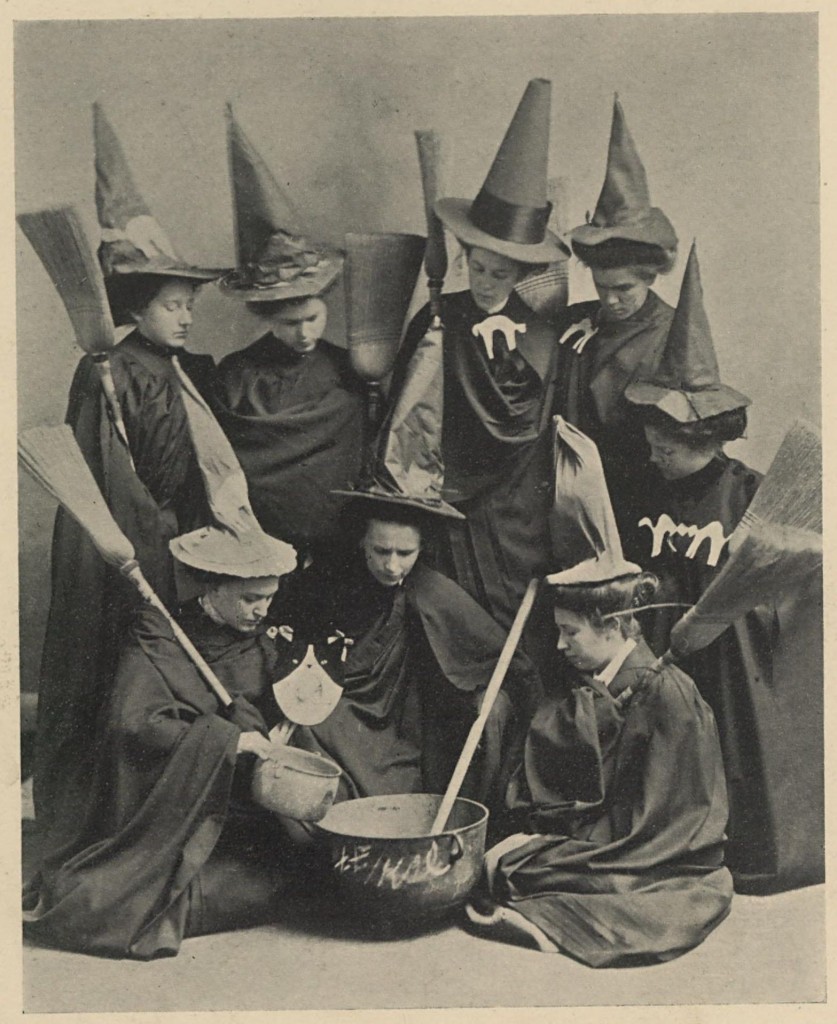
Witches Club, Presbyterian College for Women, 1910.
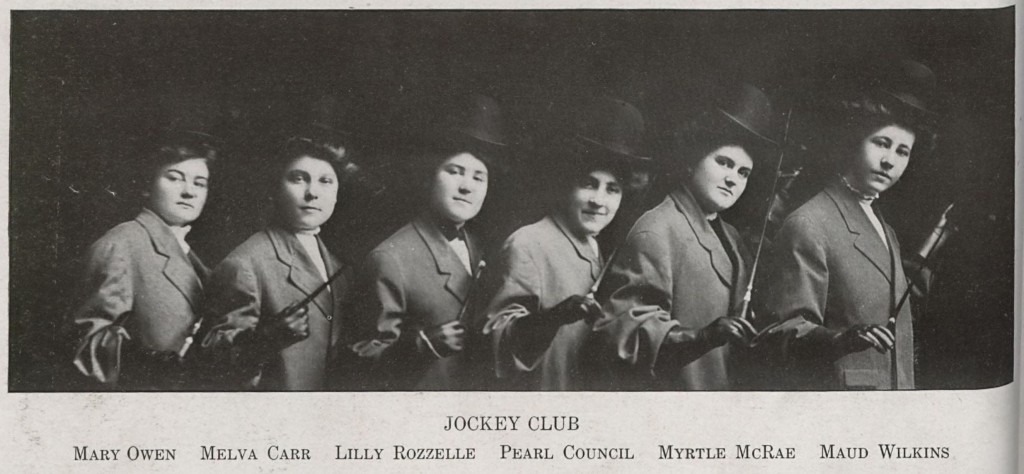
Jockey Club, Presbyterian College for Women, 1908.
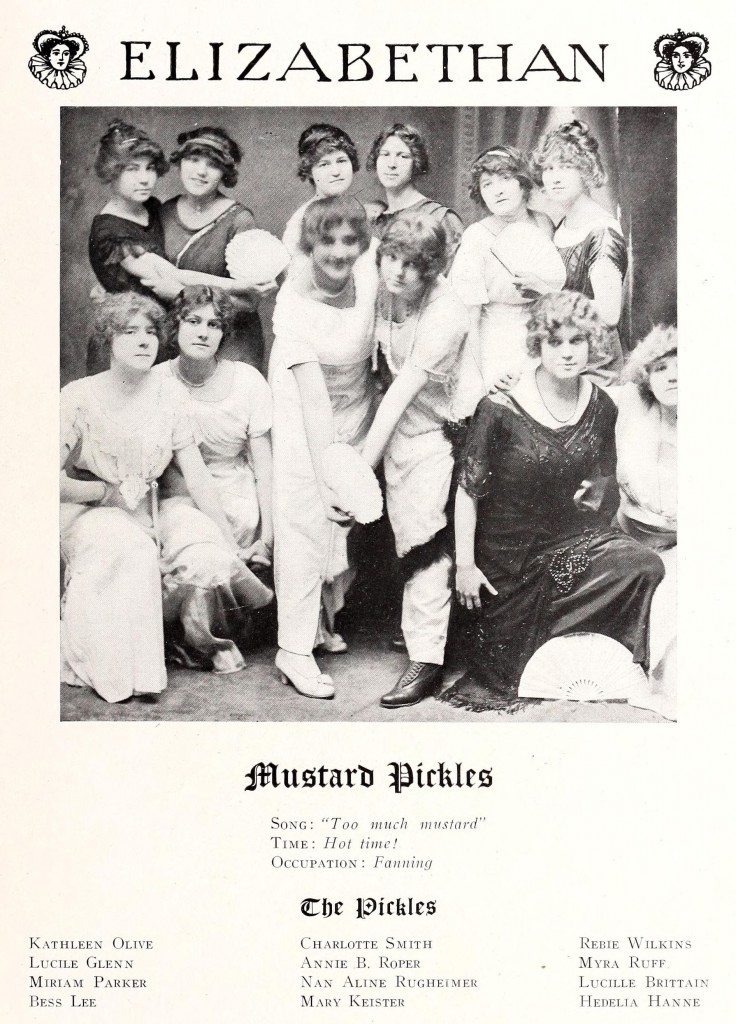
Mustard Pickles, The Elizabethan, Elizabeth College, 1914.
Elizabeth College, founded in 1897, was another early women’s college in the Queen City. The school merged with Roanoke College for Women in 1915 and moved to Salem, Virginia until 1921, when it burned and was never re-established. The Elizabeth College buildings in Charlotte endured, housing Presbyterian Hospital and the School of Nursing until it was torn down in 1980. Two yearbooks, 1914 and 1915, add to the existing eight yearbooks on DigitalNC dating from 1901. These two most recent The Elizabethan yearbooks are as charming as they are informative. Like The Edelweiss volumes from Presbyterian College for Women/Queen’s College, the club descriptions and photographs show the women both playfully and earnestly asserting their personalities, friendships, and interests. Some favorite clubs are Anti-Fat Club, Do As You Please, and Mustard Pickles. There’s also some analysis of how the women of the class of 1914 conformed (or not) to Victorian standards.
- Mecklenburg Female College
This 1868 volume is part yearbook, part literary magazine, as is characteristic of many early campus publications. This 1868 volume is both the first and penultimate volume; the school for women was only in existence for two years. The buildings were rented from the North Carolina Military Institute (later the Carolina Military Institute, also called the Charlotte Military Institute). For more information on the former Mecklenburg Female College, a broadside distributed by the college and digitized by DocSouth is particularly useful.
Several other items were also digitized from Charlotte Mecklenburg Library, including yearbook volumes 1961 and 1963 from King’s College, a small school in Charlotte founded in 1901.
Adding to our high school yearbook collection, East Mecklenburg High School years 1953 and 1954 are now available on DigitalNC. Long Creek High School, 1947 is also available.
The final item from Charlotte Mecklenburg Library is a program from the 16th Women’s History Hall of Fame Induction Ceremony by the Charlotte Club of the National Association of Negro Business and Professional Women’s Clubs, Incorporated. The four inductees were Carolyn A. Flowers, Shirley L. Fulton, Vi A. Lyles, and Joyce D. Waddell. The program also includes a list of all members of the the Women’s History Hall of Fame.
You can view all of the items digitized for Charlotte Mecklenburg Library on DigitalNC here.
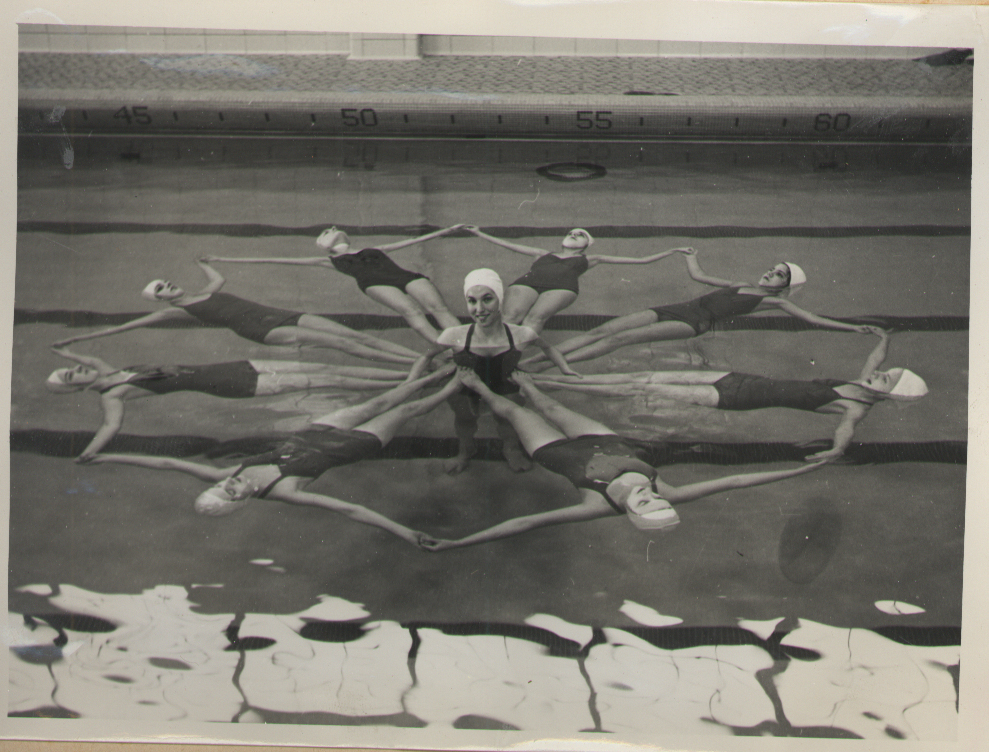
A synchronized swimming class from Queens University of Charlotte
Over one hundred historic images of Queens University of Charlotte are now available online. The photographs, circa 1950s, depict both formal and informal scenes of student life at the school, including dances, sports, stunts, classes, and dorm life.

Student yearbooks from Queens University of Charlotte are now available on DigitalNC. The yearbooks span 70 years of Queens history, from 1937 to 2007.
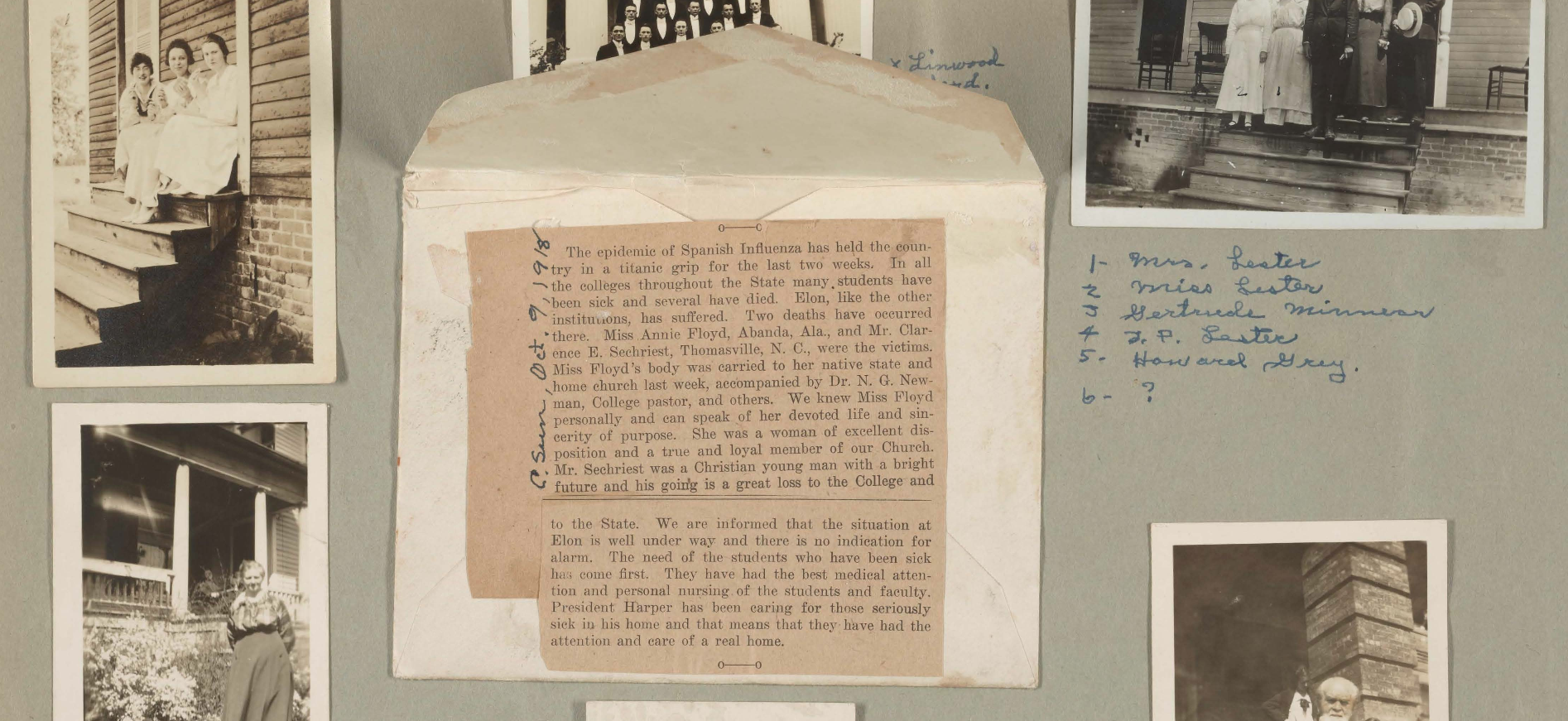
Page 31 of Annie Gordon Floyd’s scrapbook, a student at Elon College during the influenza pandemic of 1918. The newspaper clipping is Annie’s obitual; she died of influenza.
Here at the University of North Carolina, Chapel Hill, as well as across the globe, graduating students are leaving their school years behind without the normal pomp and circumstance. After years of late-night study sessions and racing to beat the assignment submission clock on Sakai, who would have thought that a pandemic would get between them and their walk across the commencement stage? While achieving a degree is a reason to celebrate regardless of location, perhaps 2020 graduates and all self-isolating students can relate to the experiences of an older group of students- those affected by the 1918 influenza pandemic.
Cutting through the spring of 1918 to 1919, the influenza pandemic was a worldwide health issue not unlike today. In North Carolina, industries were halted and quarantine was enacted (and extended). Universities, too, established their own versions of quarantine. Thanks to the institutions we work with here at DigitalNC, we have digitized yearbooks, scrapbooks, and college publications that offer a glimpse into the thoughts of students during this equally tumultuous time in history.
Quarantine was enacted in fits and spurts on campuses across North Carolina between 1918 and 1920. As is evident by yearbook social calendars, measures varied across universities. One campus quarantined through most of November 1918 while others were still starting up quarantine periods in February and March 1920.
Campus clubs have a dedicated slice of yearbook real estate during this time and the influenza directly impacted their activities. As the pandemic coincided with the last days of World War I, Student Army Training Corps (S.A.T.C.) were a part of many universities. The S.A.T.C. at Meredith College recounts their quarantine movements that saved faculty and students from “nervous prostration”. UNC’s S.A.T.C. found the flu less inspiring. Other students responded by creating clubs. At Queens College, Quarantine Club, seen left, first began in 1918 with the aim “to extend the quarantine”. Later, in 1920, the club edited their name to simply “Flu” Club, as seen below.
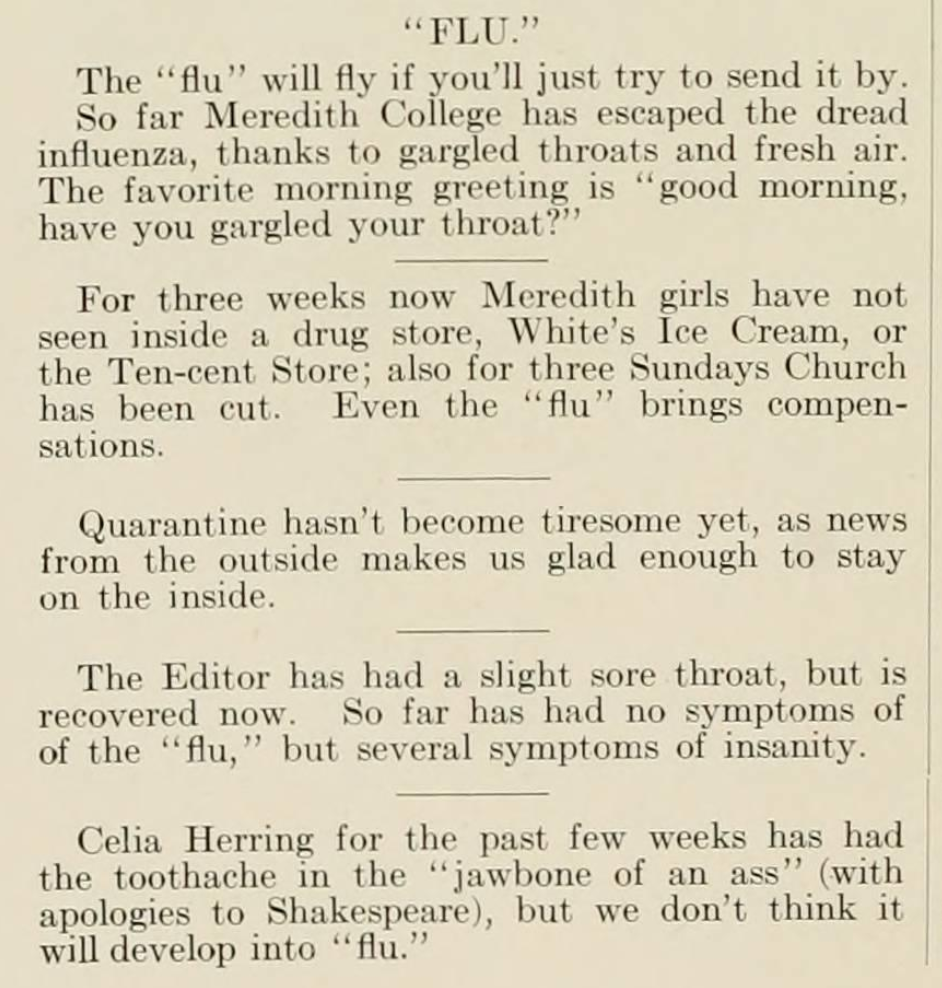
“Flu” section of the Meredith News and Distributor by French Haynes, Oak Leaves, 1919.
Students also utilized their yearbooks to creatively vent frustrations. In 1918, Atlantic Christian College students were under quarantine from February 6th to the 27th. Student Bonita Wolff penned several poems for The Radiant, including “Quarantined”, shown above. Another funny quarantine themed poem can be found in the advertisement section of the 1920 edition of St. Mary’s Muse.
Meredith College graduate French Haynes embedded influenza jokes throughout the satirical Meredith News and Distributor, shown to the right. And in 1920, Elizabeth Gaskins spotted a deficiency in her local health care system, due in part to the influenza, and argued for the creation of a local hospital in the Greenville High School yearbook The Tau.
If anything, these yearbooks serve as a reminder that this moment is not permanent. Comparing pandemics may be apples to oranges, especially when one student called quarantine “an awful bore” in a college that was only under quarantine for a month at a time, but Mary Reed Buchanan, member of the 1919 graduating class of the women’s college Peace Institute, offers some perspective in the senior class history:
With the warm spring came the renewal of all our former pleasures. There were parties galore, and girls, will you ever forget those State College receptions? And do you remember those exciting basketball games and the serenades afterwards? The feeling of being well again and out of quarantine brightened every heart and lightened every burden.
Even though we may not be attending basketball games anytime soon, we can look to those who have gone through a pandemic before and know that life, including student life, continues on. And for those who are graduating, Mary Reed Buchanan, noted suffragette, has final words:
For a look at all of DigitalNCs college and high school yearbooks, click here. Or, to view all memorabilia including scrapbooks, click here.
Mascots are a complicated phenomenon. They inspire a spectrum of reactions: ridicule, ambivalence, or fierce loyalty. With thousands of yearbooks online, all of us here at the Digital Heritage Center have probably spent more time looking at yearbooks than anyone else you’re likely to meet. Mascots are a common theme.
I’ve been working on today’s post for quite some time; unable to find a history or comprehensive list of mascots in North Carolina I decided to compile one myself. So here’s a stab at a college mascot overview, drawn from yearbooks and other campus publications. Let me know what I’ve missed or gotten wrong!
Children
In the early 20th century, schools frequently chose children as mascots or sponsors, whether for a sports team or for a particular class. The earliest example we’ve found on DigitalNC is from a 1910 publication by Atlantic Christian College (now Barton College) in Wilson, which shows Elizabeth Settle Caldwell as the Senior Class sponsor.
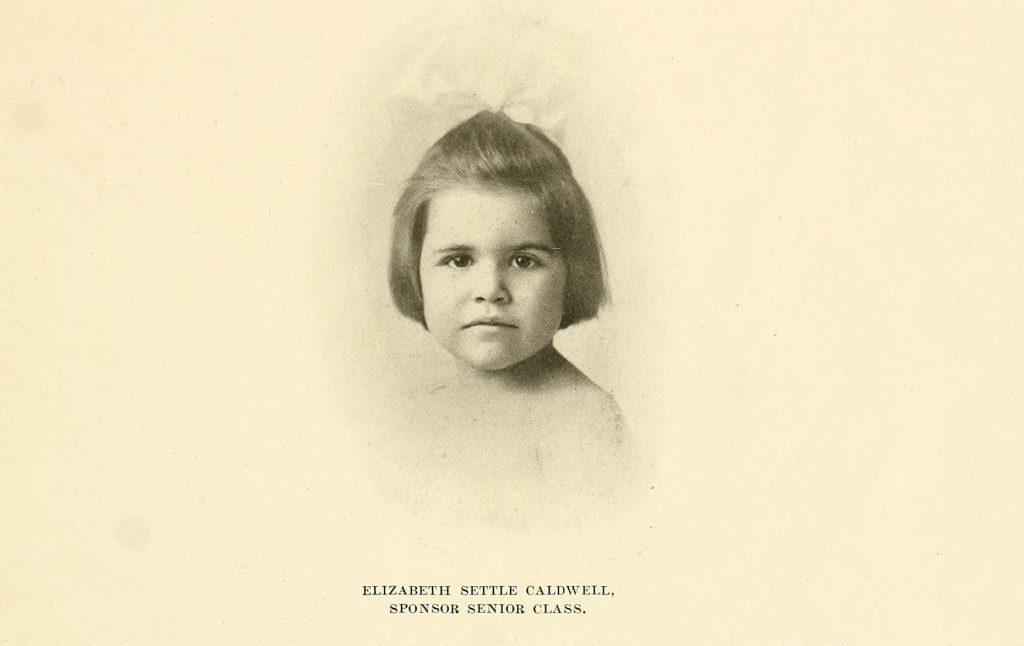
Elizabeth Settle Caldwell, First North Carolina Mascot? From the 1910 Pine Knot yearbook, Atlantic Christian College.
Ms. Caldwell was the daughter of Jesse Cobb Caldwell, the college president. From what we’ve been able to tell, children mascots were frequently younger siblings of students, teachers, or others associated with the school. Students mention that Ms. Caldwell brought “solace to many a lonely, homesick heart” and this may be why children were chosen – to foster a feeling of family and comfort among students. We’ve seen several references to mascots being elected or being chosen through competition, although what this might be we haven’t been able to discover. The trend of choosing children as mascots seems to continue through the 1960s. The latest one we found is Dawn, the Senior Class mascot at Peace College (now William Peace University) in 1966.
Animals
Animal mascots span schools across the state, whether it’s Rameses at UNC-Chapel Hill or WCU’s Catamount. The bulldog and different types of cats win out as most frequently adopted. Pictures of live animal mascots start to appear in yearbooks in the early 1900s, and continue today although much less frequently. For a variety of reasons, including concerns expressed by animal rights activists, schools have shifted away from actual animals to students dressing up like animals, as you’ll see later on in this post.
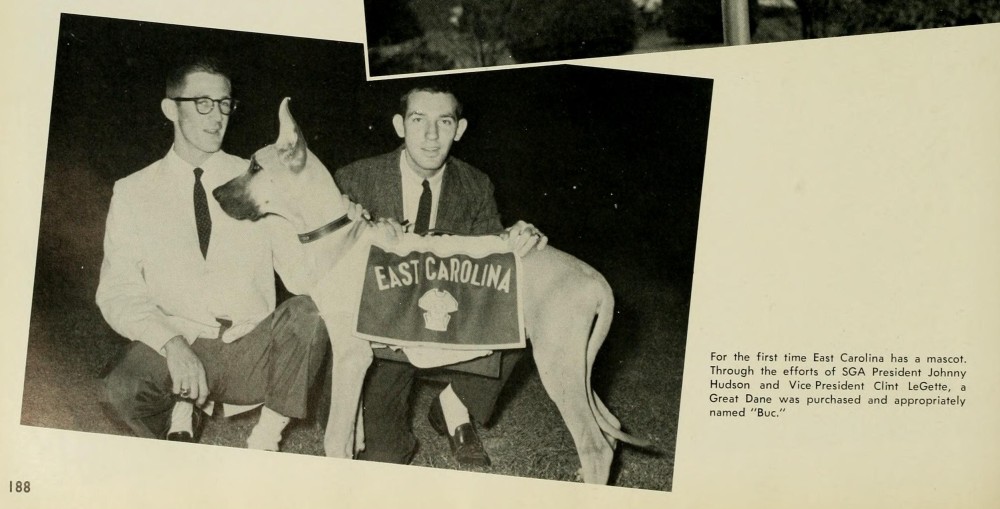
“Buc” is described here as East Carolina University’s first mascot. From the 1959 Buccaneer yearbook.
Characters
While about half of the four-year college mascots in North Carolina are animals, most of the others are characters that are historic, mythical, or extraordinary in nature. From what I’ve seen in NC yearbooks, humans dressing up as the school mascot really got traction in the 1960s. Initially, these costumes weren’t the fuzzy creations we think of today, but rather less complicated ensembles where the mascot’s identity (his or her face and body) was often apparent. Yosef the Mountaineer, beloved icon of Appalachian State University, was created sometime around 1942 and looked like this in the 1960s:
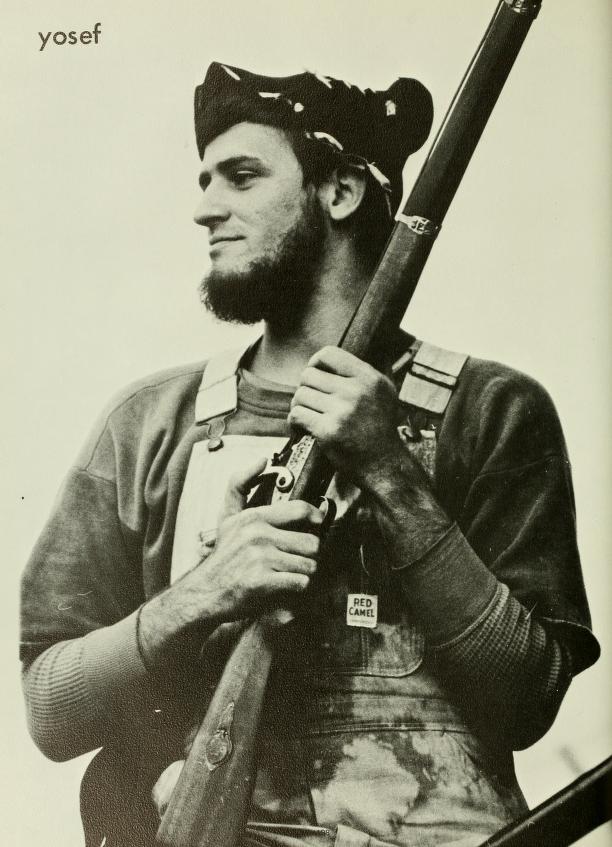
Yosef the Mountaineer, aka James Randle Tedder (we think). From the 1969 Rhododendron yearbook, Appalachian State University.
One of my favorites has to be this picture of Duke Blue Devil, from 1950:
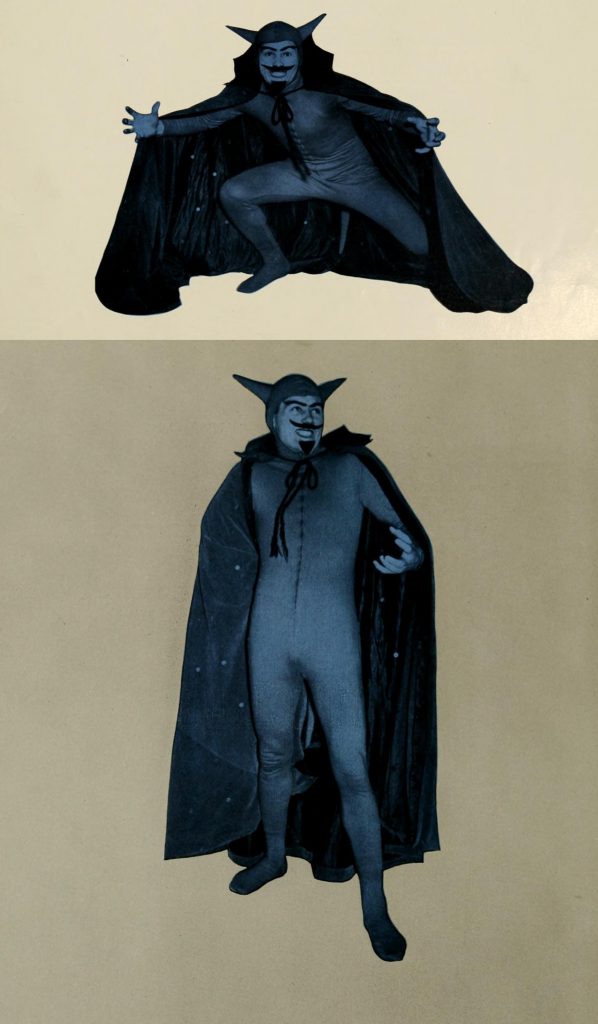
The Blue Devil. From the 1950 Chanticleer yearbook, Duke University.
Perhaps it was too hard to maintain a degree of consistency as students graduated over the years, and mascot anonymity seemed like a better idea. Whatever the reason, you start to see fuzzy, oversized costumes with gigantic headpieces in the late 1970s.
The Big Costumes
Whether animal or character, plush mascots that include a single piece body suit with a large plastic or cloth-covered head is something most Americans can identify with, thanks to professional sports. Colleges in North Carolina really embraced these costumes through the 1980s. Here’s what the UNC-Wilmington Seahawk looked like in 1987:

The Seahawk. From the 1987 Fledgling yearbook, UNC-Wilmington.
Some schools have developed multiple mascots dedicated to different audiences. It seems like the difficulty with these types of costumes is how to pull off a fierce facial expression that doesn’t come off as goofy or too scary for children. I think this picture from Davidson College sums it all up:
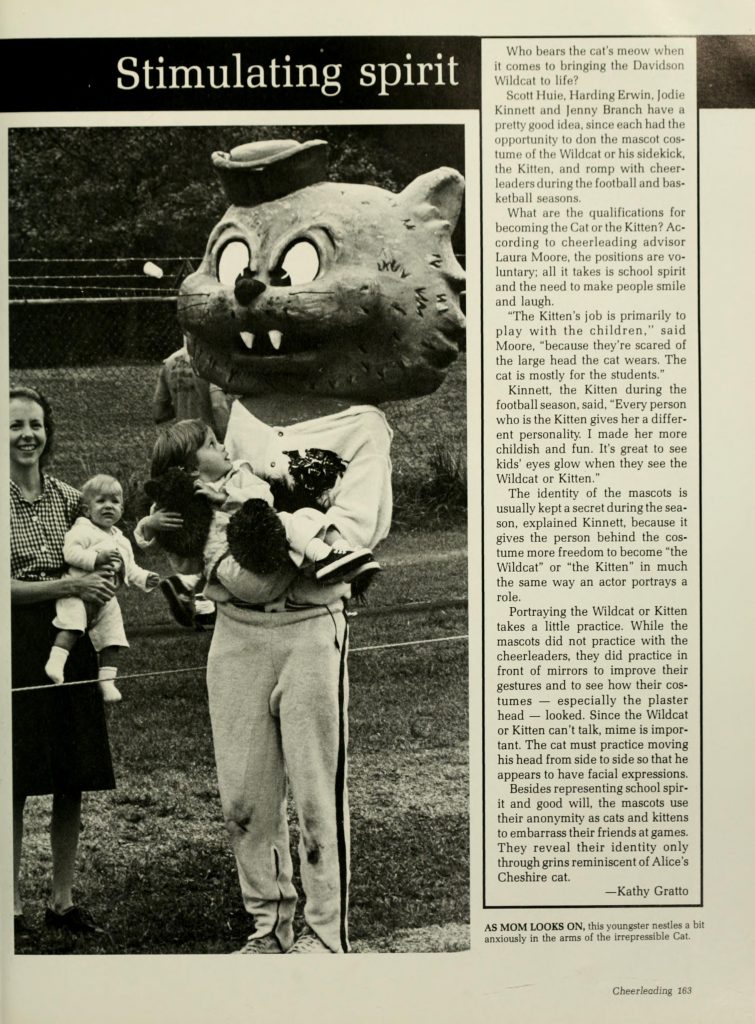
The Davidson Wildcat and … friends. From the 1983 Quips and Cranks yearbook.
I will also take this opportunity to mention a mascot that routinely makes the “wait … what?” list – the Campbell University Fighting Camels:
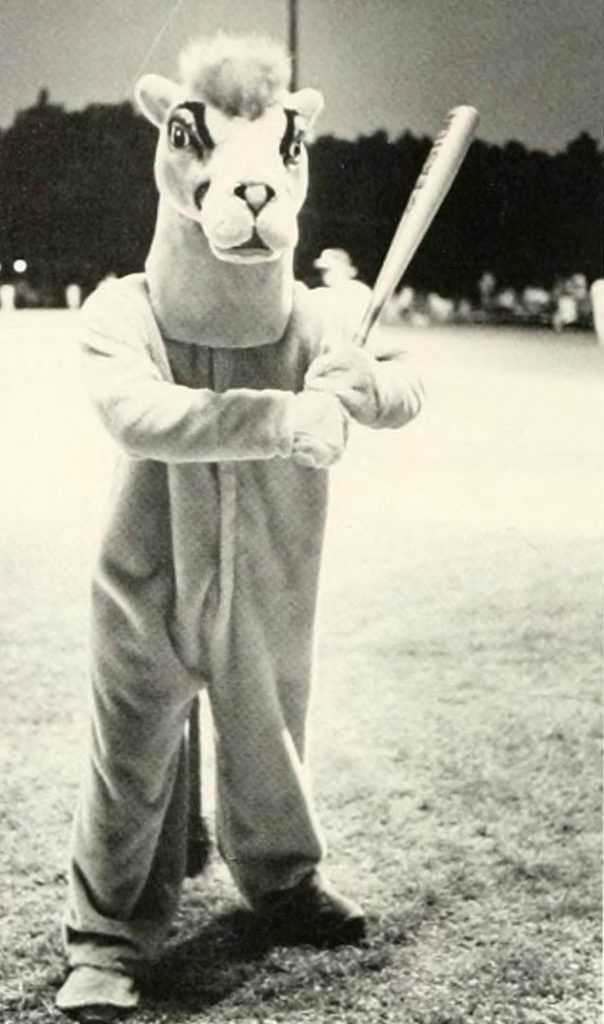
The Campbell Camel. From the 1983 Pine Burr yearbook.
Even the humans and human-like creatures are clothed in oversized costumes these days. Wake Forest University’s Deacon is a dapper chap:
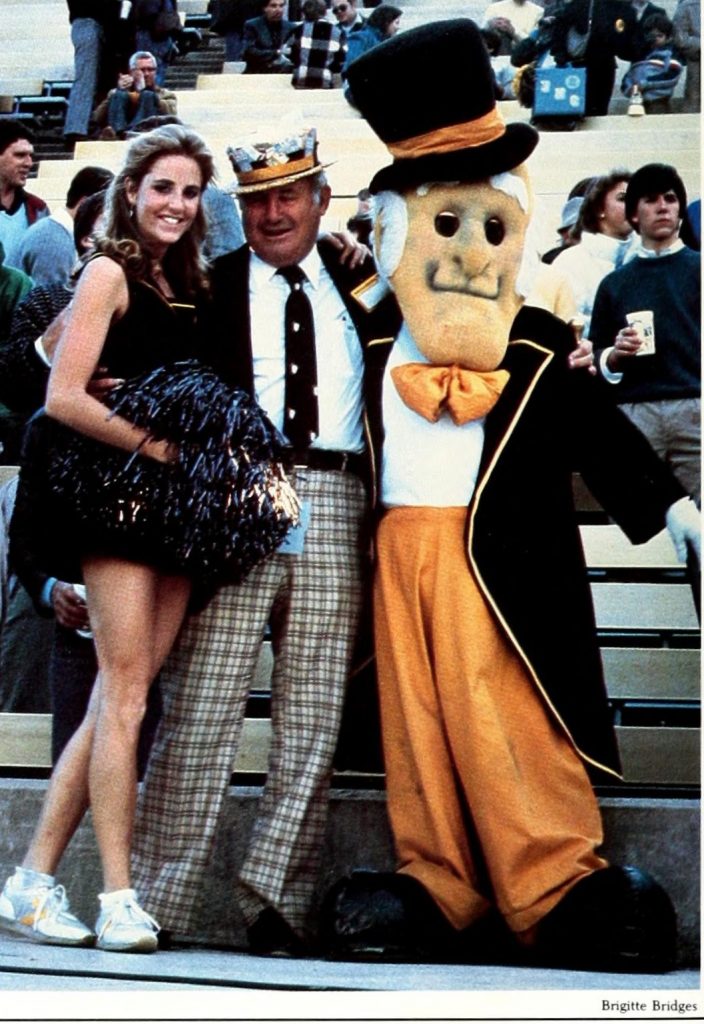
Wake Forest’s Deacon poses with fans. From the 1985 Howler yearbook.
In addition to the Demon Deacons and the Blue Devils, North Carolina boasts a number of other spiritual mascots: North Carolina Wesleyan’s Battling Bishops, Belmont Abbey’s Crusaders, and Guilford College’s Quakers. Meredith College’s teams are known as the Avenging Angels (formerly just the Angels). While Elon University’s mascot is now the Phoenix, before 2000 they were the Fighting Christians:
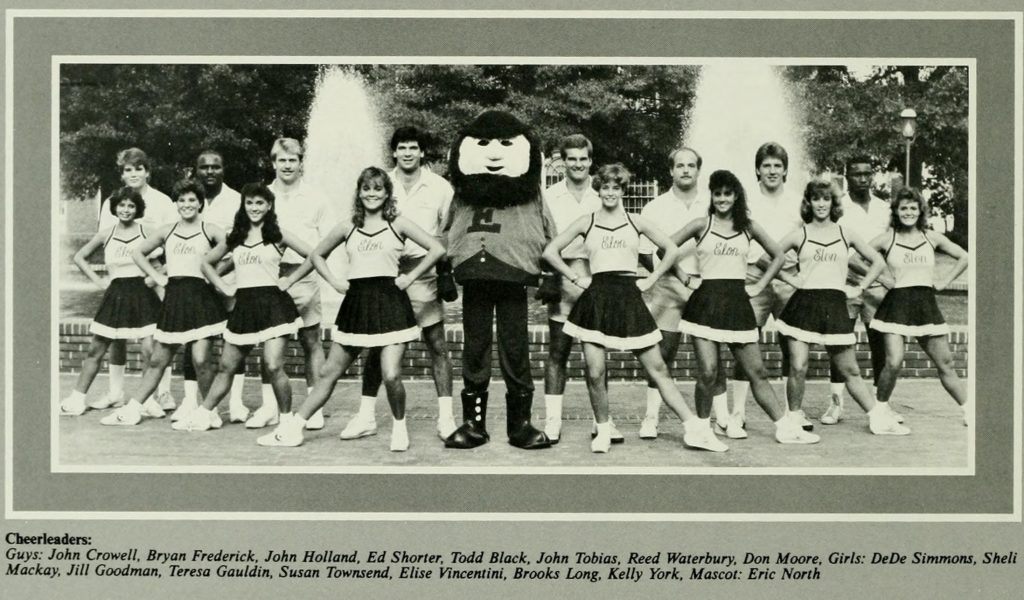
The Elon Fighting Christian mascot with cheerleaders. From the 1986 Phi Psi Cli yearbook.
Two schools break with the animal/human tradition in North Carolina. The Brevard College Tornadoes and the Louisburg College Hurricanes. Weather phenomena mascots are always difficult to pull off. I couldn’t find one for Brevard, but Louisburg, which currently has a bird mascot, had “Louie” up until 2006:
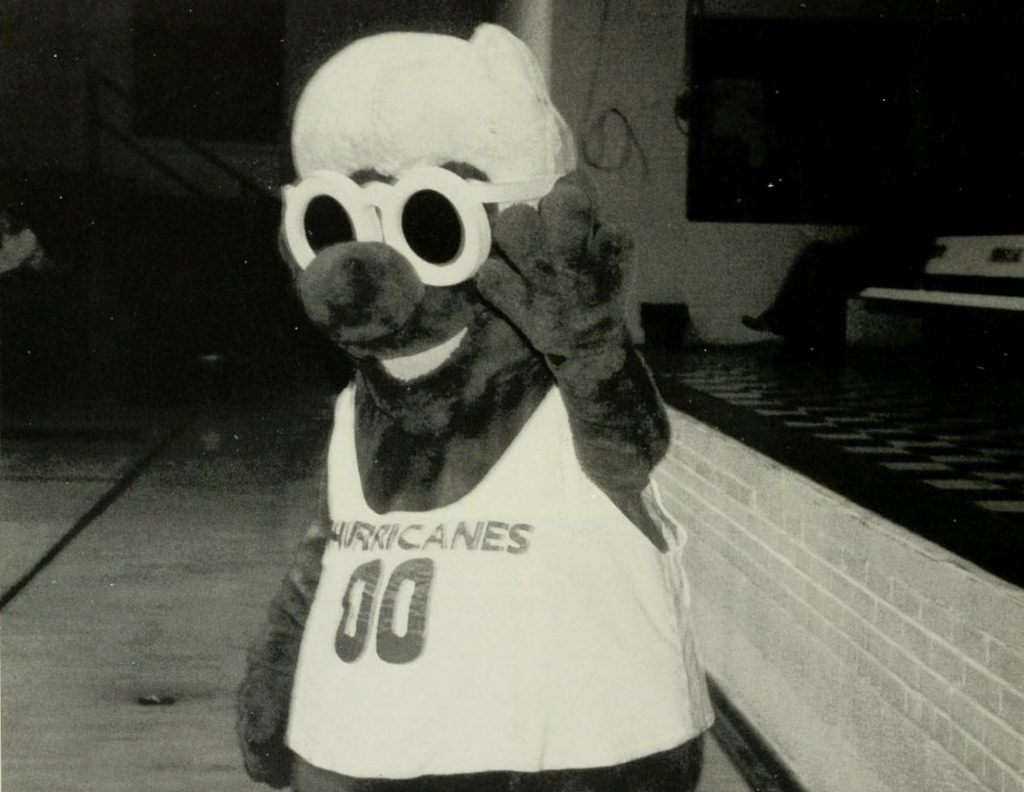
Louie, the former Louisburg College Hurricanes mascot. From the 1996 The Oak yearbook.
Who knows when the next mascot sea change will happen. Below is a list of mascots in North Carolina; let us know if we got anything wrong. Which one is your favorite?
| School |
Mascot |
Notes |
| Appalachian State University |
Yosef the Mountaineer |
First appeared in the yearbook in 1942 |
| Barton College |
Bulldog |
|
| Belmont Abbey College |
Crusader |
|
| Bennett College |
|
Known as the Bennett Belles |
| Brevard College |
Tornado |
|
| Campbell University |
Fighting Camels |
The Hornets in the 1920s-1930s |
| Catawba College |
Catawba Indian |
|
| Chowan University |
Hawks |
The Braves until 2006 |
| Davidson College |
Wildcats |
Also a bulldog (1929) and a bobcat (1939) |
| Duke University |
Blue Devil |
|
| East Carolina University |
Pirates |
Formerly Pee Dee the Pirate |
| Elizabeth City State University |
Vikings |
|
| Elon University |
Phoenix |
The Fightin’ Christians until 2000 |
| Fayetteville State University |
Broncos |
|
| Gardner-Webb University |
Runnin’ Bulldogs |
|
| Greensboro College |
The Pride |
Formerly the Hornets |
| Guilford College |
Quakers |
|
| High Point University |
Panthers |
|
| Johnson C. Smith University |
Golden Bulls |
|
| Lees-McRae College |
Wily the Bobcat |
|
| Lenoir-Rhyne University |
Joe and Josie Bear |
|
| Louisburg College |
Hurricanes |
|
| Mars Hill College |
Mountain Lion |
|
| Meredith College |
Avenging Angels |
Formerly the Angels |
| Methodist University |
Eagles |
|
| Montreat College |
Cavaliers |
|
| Mount Olive College |
Trojans |
|
| North Carolina A&T |
Aggie Dog (Bulldog) |
|
| North Carolina Central University |
Eagles |
|
| North Carolina State University |
Wolfpack |
|
| North Carolina Wesleyan College |
Battling Bishops |
Formerly the Circuit Riders |
| Peace College |
Pacer |
|
| Pfeiffer University |
Falcons |
|
| Queens University of Charlotte |
Rex the Royal |
|
| Saint Augustine’s University |
Mighty Falcons |
|
| Salem College |
Spirits |
|
| Shaw University |
Bears |
|
| St. Andrews University |
Knights |
|
| UNC Asheville |
Bulldog |
|
| UNC Chapel Hill |
Rameses the Ram |
Also known as the Tar Heels |
| UNC Charlotte |
Norm the Niner |
|
| UNC Greensboro |
Spartans |
|
| UNC Pembroke |
Braves |
|
| UNC Wilmington |
Seahawk |
|
| UNC School of the Arts |
Fighting Pickle |
|
| UNC School of Science and Math |
Unicorn |
|
| Wake Forest University |
Demon Deacons |
|
| Warren Wilson College |
Owls |
|
| Western Carolina University |
Catamount |
“Paws” |
| Wingate University |
Bulldog |
|
| Winston-Salem State University |
Ram |
|
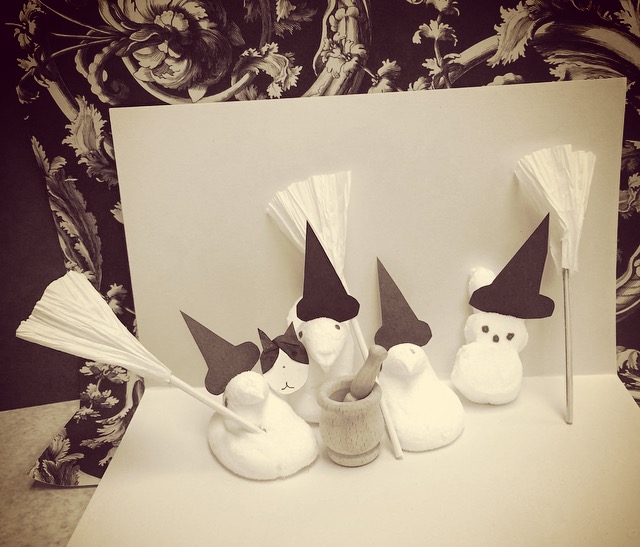
The peep witch club.

Witches Club, Presbyterian College for Women, 1910.
In celebration of the beginning of Spring, we decided to recreate a favorite yearbook photo at DigitalNC. The photograph is of a students’ Witches Club, and it comes from the 1910 yearbook “The Edelweiss,” from the Presbyterian College for Women, a precursor to Queens University of Charlotte. You can read more about it in a past blog post.
Inspired by other libraries, we created our own peep diorama, complete with cauldron, broomsticks, hats, and a cat to celebrate one of the many great North Carolina school clubs on DigitalNC.
We wrote about May Queens a couple of years ago, but can’t help showcasing them again. This time, we’re bringing you a gown per decade from North Carolina’s High Schools, Colleges, and Universities. (We picked 2 from the 1990s because we just couldn’t decide.)
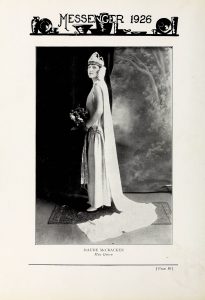
Maude McCracken, May Queen in 1926
The Messenger Yearbook, 1926 (courtesy Durham Public Library)
The Lotus Yearbook, 1938 (courtesy William Peace University)
The Anchor Yearbook, 1948 (courtesy Gardner-Webb University)
B-Somebody Yearbook, 1958 (courtesy Edgecombe County Memorial Library)
The Zenith Yearbook, 1964 (courtesy High Point University)
The Golden Bull Yearbook, 1972 (courtesy Johnson C. Smith University)
The Circle Yearbook, 1986 (courtesy Mitchell Community College)
Arete Yearbook, 1990 (courtesy Queens University of Charlotte)
The Gate Yearbook, 1991 (courtesy Wingate University)
Thanks to our newest partner, Burwell School Historic Site / Historic Hillsborough Commission, over 50 new records are now available on our website. These materials focus primarily on Margaret Anna Robertson Burwell; the Burwell family; and The Robert and Margaret Anna Burwell School. These materials, which include diaries and letters, provide a look into 19th century life and education in Hillsborough, North Carolina.
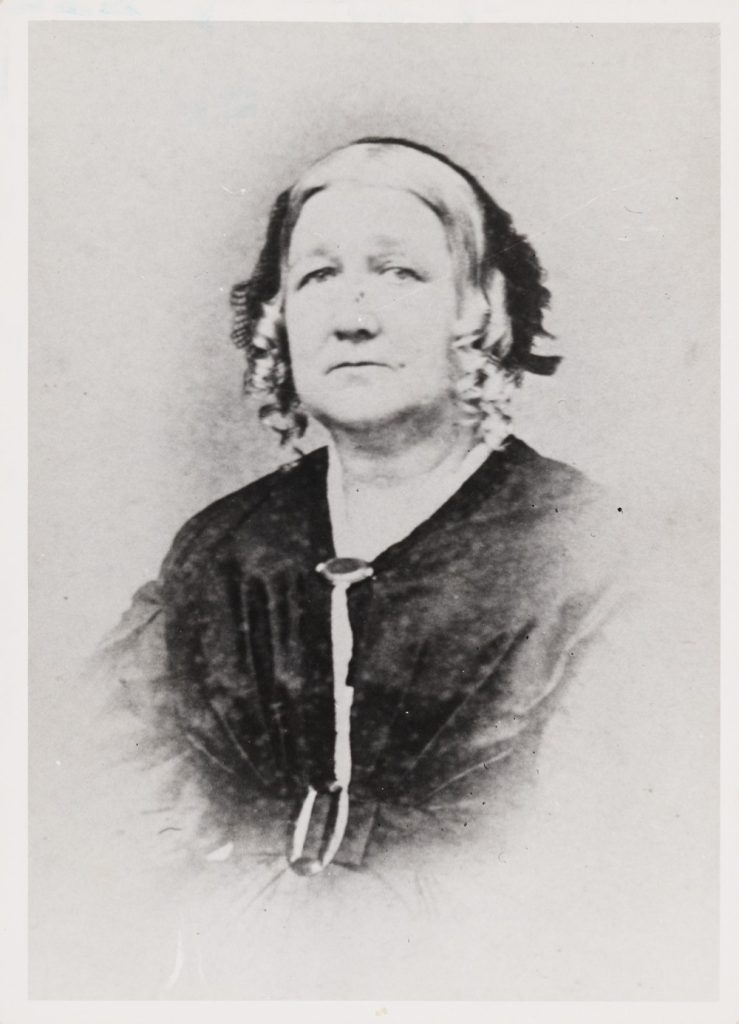
Margaret Anna Robertson Burwell
Margaret Anna Robertson Burwell, who went by Anna, is noted as an early pioneer for women’s education in North Carolina. She was born in and raised primarily by her maternal aunt, Susan Catherine Robertson Bott, in Virginia. Leading up to her arrival in the Old North State in the mid-1830s, Anna had received a good education, acquired teaching experience, married Presbyterian minister Robert Armistead Burwell, and had two children (Mary Susan Burwell and John Bott Burwell). While pregnant with their third child in 1835, Anna and her family moved to Hillsborough, North Carolina after her husband was called to be the minister of the Hillsborough Presbyterian Church.
Their first two years in Hillsborough, the Burwell family survived on Robert’s income as a minister. With an additional child and eventually more on the way, however, Anna decided to supplement her husband’s income by teaching after a local doctor asked her to undertake the education of his daughter. You can dig deeper into Anna’s life during this period by reading her digitized diaries on DigitalNC.
The Robert and Margaret Anna Burwell School and Continued Women’s Education
With Anna’s mind set on teaching, the Robert and Margaret Anna Burwell School (also referred to as the Burwell School) was opened in 1837. From its opening to its closure in 1857, Anna taught classes, handled student accounts, managed the school as well as her household.
During its 20 years of operation over 200 young women from North Carolina, Virginia, Tennessee, New York, and Florida were taught in accordance with the school’s mission to “qualify young ladies for the cheerful discharge of the duties of subsequent life […] [and] to cultivate in every pupil a sense of her responsibility for time and for eternity.” To complete their mission, The Circular [1848-1851] shows that the students took classes such as Lessons on Astronomy, Watts on the Mind, Parsing Blank Verse, Philosophy of Natural History, and Botany.
Though the Burwell School closed in 1857, the family was not finished contributing to women’s education in North Carolina. In fact the same year the Burwell School closed, the Burwells assumed leadership of the Charlotte Female Seminary (now Queens University in Charlotte, North Carolina). Fourteen years after assuming leadership of the Charlotte Female Seminary, Anna passed away at the age of 61. Possibly due to his wife’s death, Robert and their son John left Charlotte, North Carolina and assumed ownership of a different girls’ school named Peace Institute (now William Peace University in Raleigh, North Carolina).
Property History After the Burwell Family
Following their departure, the property was rented out by the Burwell family to various individuals until 1862. In November 1862, members of the Collins Family (from Somerset Place near Edenton, North Carolina) bought the property and lived there during the Civil War. Seven years later in 1869, the property was auctioned off as a result of the Collins Family being unable to afford to keep the home. The winning bid was placed by David Parks.
From 1869 to 1895, the home changed hands between the Parks brothers, David and Charles. It is believed that during this 26 year period designer Jules Kerner was hired to raise the first floor ceilings and add the Victorian embellishments found on the interior and exterior of the home.
In 1895, Charles Park sold the property to a local dentist named John Sanford Spurgeon and his wife Carrie Spurgeon. The couple brought in even more exciting updates during their lengthy ownership which included the addition of electricity and plumbing. The home stayed in the Spurgeon family for 70 years until the children of John and Carrie decided to sell it in 1965.
The property was obtained by the Historic Hillsborough Commission, a non-profit organization established by the North Carolina General Assembly, in 1965. After acquiring the site, the Commission began to restore the existing buildings including the Burwell home, brick classroom, and “necessary house.”
Officially opened to the public since 1977, the Burwell School Historic Site continues to follow its mission to “maintain and preserve the Burwell School Historic Site; to interpret the history of 19th century Hillsborough for the enrichment of the public; and to celebrate and promote the culture and heritage of Hillsborough and Orange County.”
To learn more about the Burwell School Historic Site, please visit the Burwell School Historic Site website.
To learn more about Burwell family history, please visit the Burwell School’s Our History page.
To view more materials from Hillsborough, North Carolina, please click here to view NCDHC’s Hillsborough related records.
Information from this post was gathered from the materials uploaded in this batch, the Burwell School Historic Site’s website, previous Burwell School Historic Site site coordinator Carrie Currie, and from Ashlie Brewer’s knowledge from her internship at the site in summer 2022.








